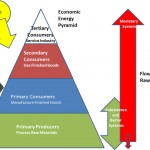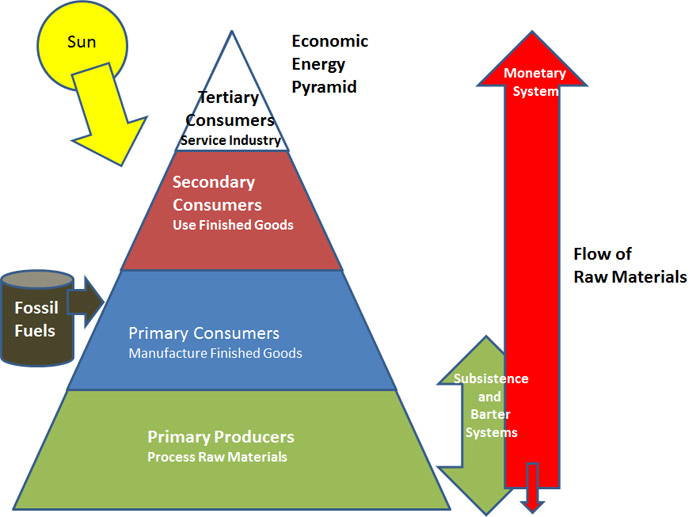 Just like natural ecosystems, economic systems flow both energy and raw materials through them. But unlike natural ecosystems, today’s economic systems are very primitive, undeveloped and crude in their use and division of resources and use of energy. Most natural systems rely on an infinite supply of energy (the sun) and are limited by raw materials. The current economic system has moved to finite fossil fuels for energy, so will be limited both by raw materials and energy.
Just like natural ecosystems, economic systems flow both energy and raw materials through them. But unlike natural ecosystems, today’s economic systems are very primitive, undeveloped and crude in their use and division of resources and use of energy. Most natural systems rely on an infinite supply of energy (the sun) and are limited by raw materials. The current economic system has moved to finite fossil fuels for energy, so will be limited both by raw materials and energy.
The stages in this flow in natural ecosystems are pretty straight forward in concept. The primary producers take the energy of the sun (or in the case of the black smokers, the energy from chemical bonds) and raw materials from the earth and water to make organic tissue. The herbivores use the organic tissue to fuel their activities and build their own bodies. The predators eat the herbivores to fuel their activities and build their own bodies, as do the predators that eat them in turn. This system is depicted as a pyramid because the total content of energy diminishes with each transfer. In a natural system, any non-living organic tissue is decomposed by other organisms and recycled into the soil, water, or air to be used again.
I have proposed an analogous depiction for the economic system — I call it the Ecolecon model. In this depiction, the diminishing levels of energy are depicted at each level. The first level is familiar in form to economists, but the next are different, they depict the continued flow of energy and raw materials. The primary consumers are the next level — that is after all for whom the primary producers are processing the raw materials. They are the equivalent of herbivores in a natural system. In a natural system, while each level actually produces something (the bodies of the organisms) after the primary producers, everything is a consumer of what was the initial raw material and stored energy. The next level is secondary consumers equivalent to the first level predators. Currently there is no obvious next level of predators. Such a system is potentially inefficient and wasteful of materials and energy. A greater the number of potential transfers more finely divides the use of the resources. This is not happening in the current economic system. So in effect the top levels of the ecolecon equivalent to predators are at present empty waiting to be filled.
Are service industries the equivalent of upper level predators? In part, because while they do not use up the processed or manufactured goods that the consumer purchased the service sector does extract fees (a form of stored energy) from both primary and secondary consumers to deliver intangible products. So these are roughly equivalent to the top predators.
So this is a very short stubby pyramid with the equivalent of herbivores (primary consumers) and only two levels of predators.
As can be seen in the part of the diagram that supplies energy, the sun and other fuels such as fossil fuels are needed for the monetary system, but not the subsistence or barter systems. In a natural system, the raw materials flow through the system until little more can be squeezed out at the last transfer (top predator). At every level, when individuals die, the raw materials contained in their bodies are recycled back by detritivores, organisms that decompose the dead organic materials. An extensive group of detritivore corporations has not yet evolved in the economic evolutionary process in response to the development of the monetary system in which raw materials are transformed to non-recyclable or even toxic materials. However, there are some. In addition, all governments are distributors and recyclers of wealth. The degree to which they are successful can be thought of as evolutionarily primitive or specialized. A government that has many levels (for example school boards, municipal, state etc.) is seen to divide the resources (a detritivore and scavenger function in nature) better than a dictatorial or feudal system that does not recycle or distribute well. Compared to the exquisite details present in a natural ecosystem, the ecolecon system is very primitive and limited in complexity and efficiency.
Harkening back to the evolutionary model of the economic system, it also is very limited in scope, having had only about 100,000 years to develop. While there are many families of animals and plants, there are only a few in the world’s combined economic systems. The same is true of the number of species. At any one time there may be 30 million species of animals, plants, and other organisms. By comparison, in an ecolecon the number of sets of similar companies — a species equivalent is very limited, perhaps a few tens of thousands.
If we look back in time at natural systems in such a primitive state, the entities that have survived are really just the basic forms of organisms primarily at the phylum and class levels. It took billions of years to develop a few “species,” (e.g. horseshoe crab) that have survived more-or-less unchanged to modern from ancient times. The natural world is replete with fantastical biological experiments that flared and disappeared. Many million of individuals did not make it, either because they did not compete successfully for resources, or could not out reproduce their competitors. On the other hand there were many empty niches waiting to be filled by new natural inventions that came along with the mutations. Over time, competitive pressures at both the time scale of ecological interactions and at evolutionary time scales created the immensely diverse and finely tuned ecosystems that thrived up until human pressures altered the land- and seascapes.
The ecolecon of 2012 is in pretty much the same state as the natural world was over half a billion years ago; a time of opportunity, innovation, experimental success, and failure. Just as then, in the modern situation, unless we use our sapient capabilities, many individuals will die from direct competition, warfare, starvation, or sickness. In a similar way to nature, human economic systems produce more individuals that can be sustained in a stable population. Our solution so far has been to extend the reach of our resources. That reach is rapidly closing. While it is too early to see the future of megacorp capitalism, this is one group of species that like the mega fauna of past eras, is going to run out of suitable resources (especially using labour as an expendable resource) to sustain itself. The next thousand years will be interesting to watch as newly evolved economic species enter the ecolecon to rise or fall. The next few years will be equally interesting to watch as the megacorp capitalists duke it out with the burgeoning mini-capitalists as they take over the control of production and distribution, and the labour unions as they evolve means to lock away distant labour resources in the ecolecon competition.

